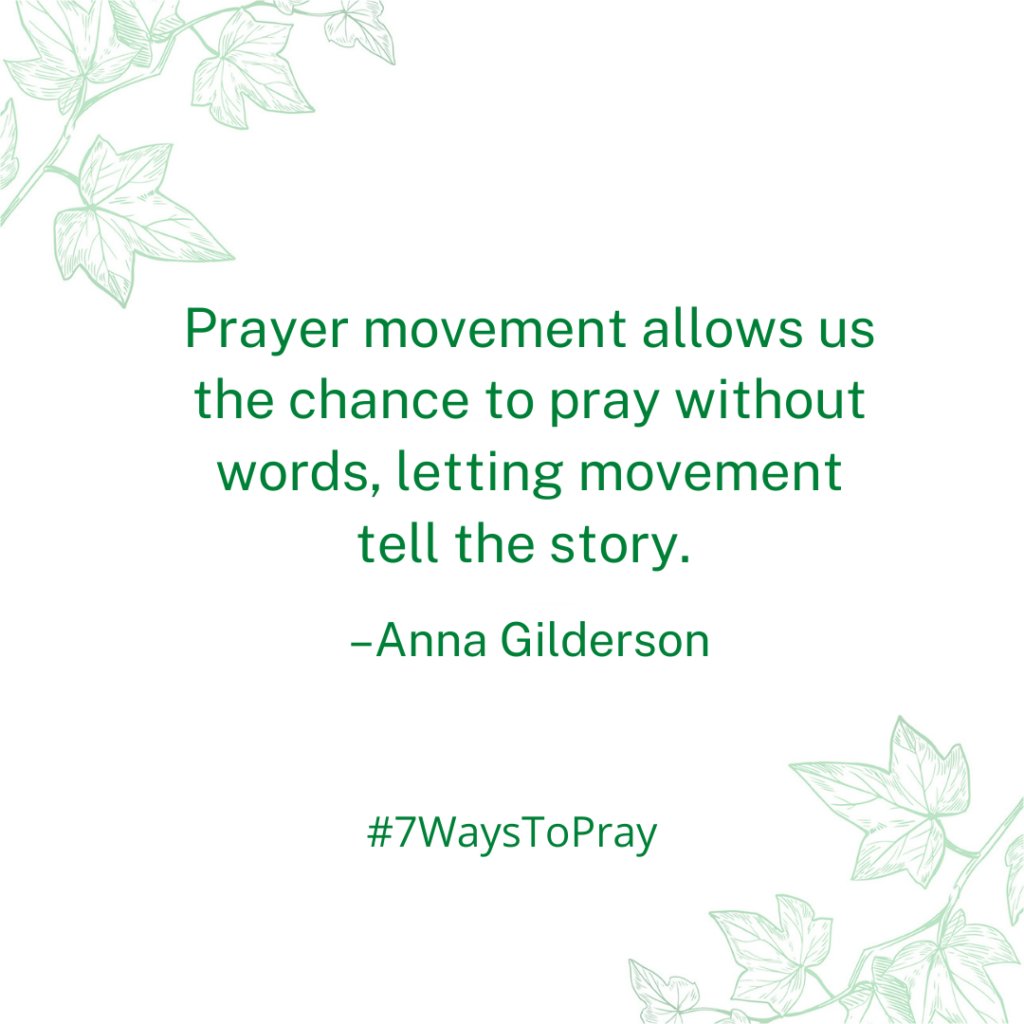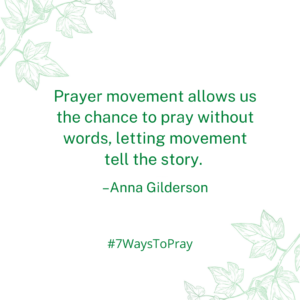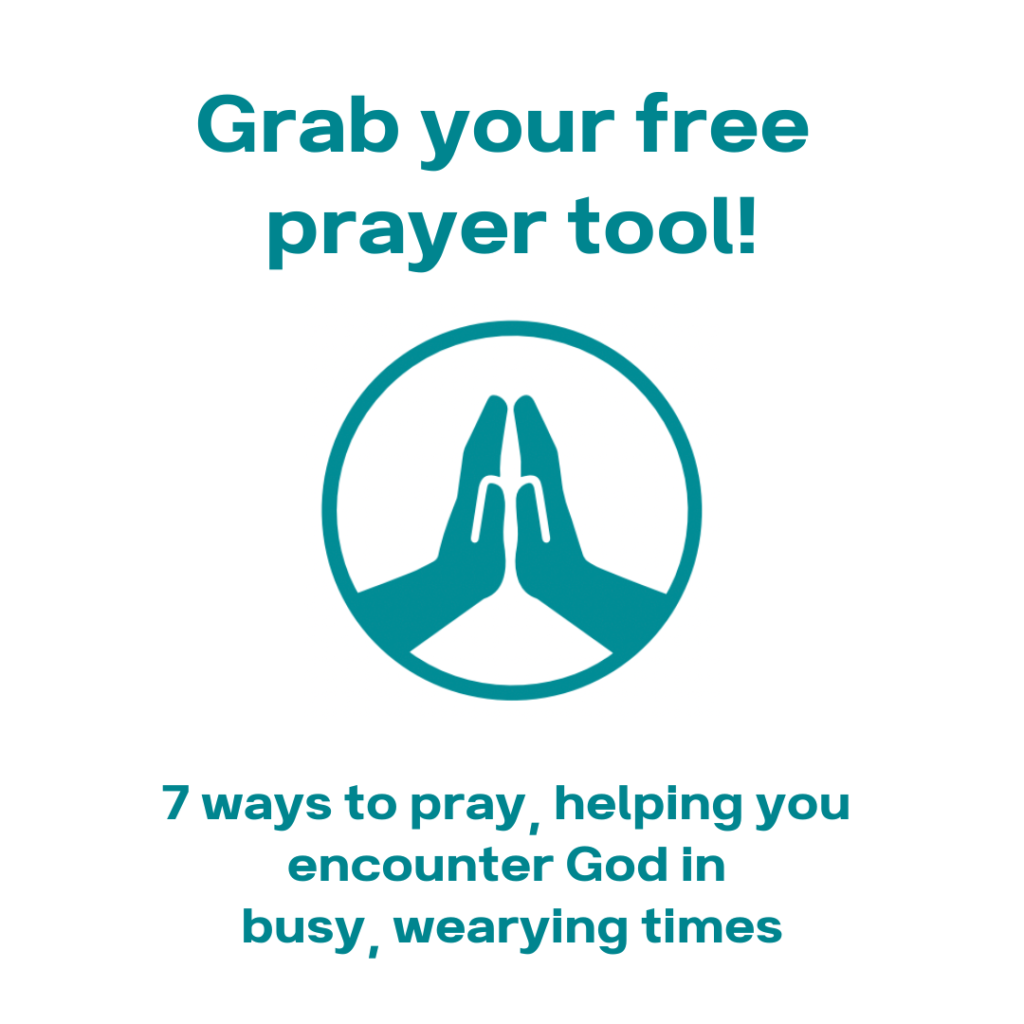“Movement and Prayer to Encounter God” by Anna Gilderson: 7 Ways to Pray blog series

Prayer with movement – I so appreciate how Anna shares different ways for us to engage with God through our bodies. After all, as she notes, we might well be using certain physical motions to pray anyway, such as folding our hands or closing our eyes. I’m looking forward to trying out her ideas, and hope you will too.

Connecting prayer and movement together can seem out of the box, but we already always use movement in our prayers. Do you close your eyes? Bow your head? Clasp your hands? They are all intentional movements that you do as you come into the presence of God for a conversation.
I love sharing with others how they can encounter more of God through adding movement to their prayers and relationship with God. At UC Grace, a Christian Dance Company that I run, we define prayer movement as…
Your body’s reaction to drawing closer to God. The external display of an internal feeling and preparation for a conversation. Its nuances that only you and God know. Fleeting moments when you choose to acknowledge your connection and conversation with God. The reality of moving through life sometimes 100 miles an hour but still always doing the same thing when you choose to pray. To have that conversation and allow intention into the time of response with God.
Put simply, prayer movement allows us the chance to pray without words, letting movement tell the story instead. Sometimes this can be influenced with music, while other times music isn’t necessary to capture and share what God is speaking through the movement.
Here are two ways that I have found useful to develop my practice of prayer movement. It can take a while to get into the rhythm of doing it, so give it time and allow God to move and work bit by bit.
Write it, learn it, move it
Think about one thing that you would like to pray for currently. Write it down into a simple written prayer. It’s important to use key words that describe what the issue is, any emotions involved, and any encouraging words. Don’t make it complicated.
Next, take the time to learn that prayer off by heart. This helps it to become ingrained so you can anticipate what is coming next. When you speak, you naturally emphasise certain words, so start to recognise the words that you are emphasising. These are your movement starting points.
Begin to put specific movements to the words that stand out to you in your prayer and practice them one after the other. The movements can be a literal interpretation of the word or something abstract. Only you know it’s meaning; it doesn’t matter what anyone else thinks it is.
For example, a prayer I regularly pray is about patience, energy and joy. Three things I can struggle with daily. ‘Father God, equip me with patience to withstand the day, energy to sustain all that I need to do and joy to flow in conversations and relationships.’ I emphasise those three words I mentioned previously doing the following movements –
- Patience: Standing feet in neutral (hip width apart), inhaling a deep breath and opening my hands out to receive.
- Energy: Bringing my hands together and rolling them over each other, taking them above my head and then opening them out into a high V shape.
- Joy: Swinging my arms down from high into a figure of 8 and doing some hops.
This is my movement prayer. That’s how simply you can build yours. I can spend some time doing this slowly, fast, big, small, anyway I want. Sometimes I will speak the words, other times I won’t. but I treat it as an offering and invitation for a conversation with God.
Let a song be your prayer dance
Words in songs can be very powerful. Often you might find yourself either picking up on one or two key phrases or becoming enveloped in the song completely. Worship songs bring a different layer to our prayers. Many are written as heartfelt prayers, words directly from scriptures or specific words from God. This can be a natural way move your prayer.
Think about some of the songs that you love – what parts of them are your prayer right now. Take some time to respond to those words, and, just like I mentioned above, learn them. Then in those moments when you need to remember that prayer you can simply move it – without the need for music.
As I’ve journeyed with prayer movement, I’ve experienced a closeness with God that’s hard to describe. Praying can sometimes be hard work. But when I choose to use movement instead, I feel freedom, a change in the atmosphere, and a joy that sparks a desire to keep seeking Jesus.
I hope you enjoy have the chance to experience this too.

Anna is dancer, teacher, choreographer and writer. She has two crazy children and a husband in the military. Anna is the author for Jesus for Kids: Teaching Dance and Sharing Faith, and Movement, Prayer and Scripture is due for release at Easter. Anna’s passion is to teach and share her knowledge about the interaction between dance and movement and how that exploration helps us to have a deeper conversation with God. She runs regular trainings, workshops and dance weekends and blogs at www.ucgrace.co.uk/Blog. She loves the outdoors, growing her own food and sewing clothes. You can find her on Instagram, Facebook and at her website.
Order 7 Ways to Pray here, including in the US, UK, and Australia. You’ll also find lots of resources for small groups – videos and a leader’s guide – here.








 Hello!
Hello! 